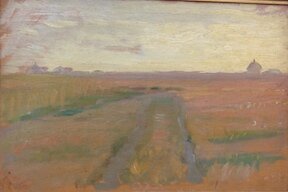Susette C. Skovgaard. Mouth of the River. 1888. Oil on canvas. 60.5 x 36.3 cm. Statens Museum for Kunst
In the 19th and 20th centuries the depiction of landscapes in prints and paintings became an important expression of contemporary life and aspect of art making. In each lecture we will look at a different facet or period of landscape painting, not just in the canon of Western Art, but in varying contexts and styles, but also as expressing different ideas.
Session 1: The Coastal Landscape in Industrial England: John Constable and J. M. W. Turner
A surge in landscape painting in Europe accompanies the industrial revolution. Two of the greatest romantic landscape painters, John Constable (1776-1837) and J. M. W. Turner (1775-1851) focused on the rapidly transforming waters and lands of Britain during the period of urbanization, large-scale industrial development and military conflict. We focus on two lesser known paintings in particular: Constable’s Weymouth Bay: Bowleaze Cove and Jordon Hill (1816-1817) and Turner’s London from Greenwich Park (1809) to both in the HOW the painting is made and constructed and the artists’ subjective view of WHAT England looked like at this time and WHY. For an interesting related scholarly article from the Tate on Constable’s Salisbury Cathedral. Charles Watkins, ‘Landscape Management’, in Amy Concannon (ed.), In Focus: Salisbury Cathedral from the Meadows exhibited 1831 by John Constable, Tate Research Publication, 2017, https://www.tate.org.uk/research/publications/in-focus/salisbury-cathedral-constable/landscape-management, accessed 27 February 2021
Want to learn more about Constable and Turner? Here are some recommended resources that are available from Khan Academy, the Tate Gallery and the National Gallery, London:
Here is a biography of Constable with links to some of their paintings at the National Gallery. For a later painting that shows Constable’s interest in skies and the local landscape, John Constable, The Hay Wain (Landscape: Noon), 1821, oil on canvas, 130.2 x 185.4 cm (The National Gallery, London). Speakers: Dr. Steven Zucker and Dr. Beth Harris. The Tate explains the key elements of Salisbury Cathedral from the Meadows (exhibited 1831), a view that relates to his most important patron and an icon of British architecture.
Here you can read the National Gallery’s biography of Joseph Mallord William Turner. To learn about one of his later paintings (one that I really like), here is a link to a video on Khan Academy, Joseph Mallord William Turner, Rain, Steam, and Speed -- The Great Western Railway, oil on canvas, 1844 (National Gallery, London) Speakers: Dr. Beth Harris, Dr. Steven Zucker. The Tate has the largest collection of Turner paintings anywhere in the world, with 9 rooms devoted to the painter. They have organized a virtual viewing experience (some where you actually are taken in the rooms). Here is the link to the Tate’s launch point for looking at the Turner collection.
Session 2: The Black Tourist Gaze in North Africa: Henry Ossawa Tanner’s paintings of Morocco and Tunisia
Henry Ossawa Tanner, Street in Tangier, ca. 1910, oil on fiberboard, Smithsonian American Art Museum, Gift of James and Shirley Gordon, 1983.95.209
Henry Ossawa Turner left his home in North Philadelphia to be an expatriate mostly living in Paris, France. Although known for his religious paintings informed through travel of the Holy Land, this particular set of paintings relates to tourism and travel, the ways that artists used particular brushstrokes, light and palette to indicate the traveler’s body and knowledge of a place that was considered exotic.
Session 3: Gender and Agency as a Tourist to the Arctic Circle: Susette Holten’s paintings of the fjords and mountains of the polar regions
The rhetoric around the Arctic during the late 19th and early 19th century identified the polar landscape as white, masculine, barren and hostile. It is quite interesting to see, however, that in the midst of World War I, the Danish artist Susette C. Holten (née Skovgaard) exhibits a series of landscapes that document her travels to the polar north. We will look at how the landscape was represented and how she exhibited her own presence using a palette that drew from impressionist painting, but conveying a much different aesthetic and sense of place.
Susette C. Holten, Ranfjorden. 28 June 1916. Oil on canvas. 42 cm (16.5 in); Width: 56.5 cm (22.2 in). Skovgaard Museet. 10.137.
Session 4: The Landscape and Ecology in the Baltic: Anna Ancher’s painting of the heath and agriculture in the early 20th century.
Anna Ancher. Sunset over the Moors. Oil on wood. 26.1 x 39.2 cm. Skagens Museum inv. 1640. Photo by author.
Anna Ancher painted few landscapes before 1900. Most of her oeuvre depicted interiors and people. In the first decade of the 20th century, amidst growing controversy over heath reclamation, the rights of small farmers, and growing contact with Baltic art, there is a notable increase in the number of landscapes and their content resonates with the ecological discourse of the period.



